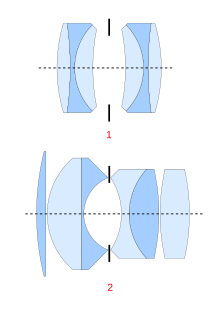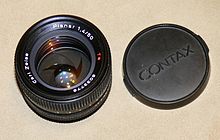Gaussian double lens
The Gaussian double lens was originally a four-lens, symmetrical lens whose basic design is still used in many cameras today. Alvan Clark developed this lens at the end of the 19th century based on a design by Carl Friedrich Gauß .
Basic construction
In 1817 Carl Friedrich Gauß worked on improving the lenses for telescopes. He calculated a lens combination that was free of spherical and chromatic aberration for central and peripheral rays . Gauss combined a front positive lens with a rear negative lens and, like Fraunhofer, received a doublet with an air gap. Even in the Gaussian version, the spherical aberration was no longer dependent on the wavelength of the light. However, these lenses were rarely used in astronomy and were produced commercially several times (Steinheil 1861, Alvan Clark 1877, Carl Zeiss 1896).
In order to reduce annoying reflections prior to the invention of the anti-reflective coatings, the designers relied on the use of strongly curved meniscus lenses .
Alvan Clark put two of these lens groups "back to back" together in 1888 - but without great success. These early constructions were designed as symmetrical four-lens elements ("Gauss type 1st / 2nd type"). The Gaussian double lenses basically belong to the group of symmetrical achromatic lenses , since they are made up of two almost mirror-image achromatic lens groups, between which the diaphragm is arranged. Spherical and chromatic aberrations were corrected well here, but not the astigmatism . Alvin Clark's son Alvan Graham Clark applied for a US patent for such a double Gauss construction (No. 399,499). From 1890-1898 corresponding lenses appeared with a light intensity of 1: 35-1: 8 as " wide angle lens " in the short term in the catalog of Bausch & Lomb on. They didn't last long here, however.
Further developments
Aristostigmatic
Some European manufacturers were more lucky with the design. In particular, the Görlitz company Hugo Meyer used the optical glasses newly developed by Jenaer Glaswerk Schott at the end of the 19th century . With this, the astigmatism could also be eliminated. Meyer called the lens, which otherwise largely followed the basic construction, the Aristostigmat . Meyer received a patent ( German Reich Patent ( DRP) 125560 of June 10, 1900) for this very successful version of a Gaussian double lens.
Modern Gaussian double lenses are mostly anastigmatic lens systems due to the use of better types of glass and / or additional lenses .
Planar (six lenses)
In 1896, the " Planar " developed by Paul Rudolph for Zeiss was presented ( German Reich Patent (DRP) 125560 from June 6, 1900.) The basic planar has six lenses in four groups. Usually you have two converging lenses in front, then the two diffusing lenses with the aperture in between, and behind them two more converging lenses. The basic form of the inner converging lenses is cemented to the diffusing lenses . The planar has a low curvature of field , from which the name planar is derived. The astigmatism is also corrected.
Many well-known camera manufacturers such as Hasselblad , Contax , Rollei and Linhof carry or have planar lenses in their lens range. The basic construction of the planar proved to be very efficient. As a result, many variants appeared. This includes the small picture planar 1: 1.4 / 50 mm according to Glatzel medium format , which was developed in the 1970s .
Variants with asymmetrical lens scheme
The planar - and thus the symmetrical Gaussian double lens - also became the starting point for a large number of other lens types. In 1920 HW Lee of the Taylor-Hobson Company abandoned the symmetrical structure and constructed an f / 2 lens (Opic lens). Following this approach, AW Tronnier calculated the Schneider Xenon f / 2 for 35mm film in 1925 and W. Merte at Zeiss calculated the Biotar as f / 2.50mm and f / 1.4.25mm for 16mm film cameras. Other examples are the Summar , Summicron , Ultron and Pancolar .
Individual evidence
- ^ Kingslake, Rudolf (1989) The History of the Photographic Lens. Academic Publishers Inc. pp. 117f.
- ↑ Krüss, Hugo 1888 The color correction of telescope lenses by Gauss and Fraunhofer, Zeitschr. f. Instrumentology, 8th year February 1888, p. 55, p. 60.
- ^ Kingslake, Rudolf (1989) The History of the Photographic Lens. Academic Publishers Inc. pp. 117f.
- ↑ http://depatisnet.dpma.de/DepatisNet/depatisnet?action=pdf&docid=DE000000125560A .
- ^ Kingslake, Rudolf (1989) The History of the Photographic Lens. Academic Publishers Inc. pp. 117f.
- ↑ http://depatisnet.dpma.de/DepatisNet/depatisnet?action=pdf&docid=DE000000125560A .
- ↑ Kingslake, Rudolf, p. 122ff.


